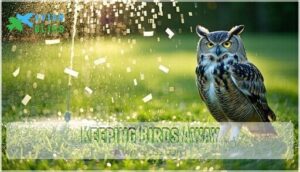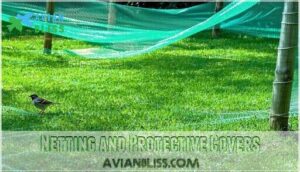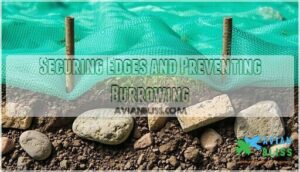This site is supported by our readers. We may earn a commission, at no cost to you, if you purchase through links.

Cover seeded areas with fine mesh netting or burlap, ensuring edges are secured to prevent access underneath.
Apply a thin layer of straw mulch or topsoil to hide visible seeds from opportunistic feeders.
Install motion-activated sprinklers or reflective tape as deterrents.
Time your seeding strategically—birds are less active during cooler weather or after rainfall when natural food sources are abundant.
Consider using coated grass seeds, which are less appealing to birds but maintain germination rates.
The key lies in layering these methods rather than relying on just one approach for maximum effectiveness.
This approach helps to ensure that the seeds have the best chance of germinating without being eaten by birds, by using a combination of physical barriers, deterrents, and strategic timing, ultimately leading to a successful seed establishment with the use of multiple protection strategies.
Table Of Contents
- Key Takeaways
- Bird Attraction Factors
- Keeping Birds Away
- Physical Barriers Work
- Effective Scare Tactics
- Combined Protection Methods
- Frequently Asked Questions (FAQs)
- Do birds eat grass seed?
- How do you keep birds away from your lawn?
- How do you protect grass seed from birds?
- How do I stop birds from eating my seeds?
- How do you protect grass seed?
- Do birds eat fresh grass seed?
- How do I overseed my lawn without birds eating seeds?
- How do I protect my grass seed?
- Will birds eat all of my grass seed?
- Does straw prevent birds from eating grass seed?
- Conclusion
Key Takeaways
- Combine multiple protection methods for maximum effectiveness—use physical barriers like netting or straw mulch alongside deterrents like reflective tape and motion-activated sprinklers rather than relying on just one approach.
- Cover your seeds with thin layers of straw, mulch, or topsoil to hide them from birds’ view, as exposed seeds on bare ground create an irresistible feeding opportunity for opportunistic birds like finches and sparrows.
- Time your seeding strategically during cooler weather or after rainfall when birds are less active and natural food sources are more abundant, giving your seeds the best chance to germinate before being discovered.
- Consider using coated grass seeds with bitter substances that deter birds while maintaining normal germination rates, and overseed by 20-30% to compensate for natural losses to bird feeding.
Bird Attraction Factors
Birds target grass seed because it’s easy to find and simple to eat compared to other food sources.
While grass seed offers less nutrition than sunflower or nyjer seeds, its accessibility and visibility on bare soil make it an attractive option for opportunistic feeders like finches, sparrows, and pigeons.
Ease of Access to Seeds
Birds find grass seed irresistible because of its easy accessibility on open ground.
Your freshly scattered seeds create an irresistible all-you-can-eat buffet for hungry birds.
When you scatter seeds across bare soil, you’re basically laying out a buffet.
Poor seed placement and shallow sowing depth make seeds highly visible to passing birds.
Proper ground cover and strategic watering practices can reduce seed visibility, making bird feeding less convenient and protecting your investment.
Nutrient Value of Grass Seed
While grass seed isn’t the most nutritious option compared to sunflower or nyjer seeds, it still provides essential carbohydrates and proteins that birds need.
The seed nutritional content varies by grass seed variety, with some offering better seed nutrition than others.
Birds supplement their diet with whatever’s available, making your freshly sown lawn an easy target.
Seed coating benefits include deterring birds while maintaining the same nutritional value for germination.
Opportunistic Feeding Habits
Opportunistic creatures thrive on easy food sources, and your freshly scattered grass seed represents exactly that.
Birds possess remarkable visual accessibility skills, scanning landscapes for cheap nutrients with minimal effort required.
Understanding bird feeding habits helps explain their attraction:
- Seed accessibility drives feeding behavior more than nutritional content
- Bird attraction increases when food sources require little energy expenditure
- Bird feeding strategies adapt quickly to available resources
- Sowing strategy timing affects bird feeding pressure substantially
- Seed overcompensation becomes necessary due to persistent bird behavior
Seed Visibility and Availability
When you scatter grass seed on bare ground, you’re basically laying out a buffet. Seeds sitting exposed on the surface catch birds’ attention immediately, making seed accessibility a primary factor in bird preference.
Smart sowing depth and proper ground cover dramatically reduce this visibility. Increasing seed density helps too – birds can’t eat everything when seeds are buried under mulch or topsoil.
Seed coating with bitter substances makes visible seeds less appealing, while deeper planting keeps them hidden until germination begins.
Keeping Birds Away
Your lawn seeding project doesn’t have to become a buffet for feathered visitors. Understanding effective bird control methods helps protect grass seed investment while respecting local wildlife. Successful bird deterrents rely on disrupting established bird behavior patterns through strategic intervention.
Multiple humane deterrents work together to stop birds eating seed more effectively than single approaches. Consider these proven bird control methods:
- Motion-activated sprinklers that startle birds with sudden water bursts
- Reflective tape creating disorienting light patterns across seeded areas
- Fake predator decoys positioned to simulate natural threats
- Wind chimes producing irregular sounds that disrupt feeding routines
- Scent-based repellents using natural oils birds find unpleasant
Repellent longevity depends on regular repositioning and maintenance. Birds also use early threat detection to avoid danger. Check local regulations regarding bird control methods before implementation. Community solutions often involve neighbors coordinating deterrent strategies across adjacent properties, maximizing effectiveness while sharing costs and responsibilities for ongoing maintenance. This approach promotes successful bird control and respects the need for humane treatment of birds, ensuring a balance between protecting your lawn and preserving local wildlife harmony.
Physical Barriers Work
When birds keep devouring your freshly sown grass seed, physical barriers offer the most reliable protection method available.
These covers create an impenetrable shield between hungry birds and your seeds, allowing grass to establish without interference.
Netting and Protective Covers
Protective netting creates an impenetrable barrier that blocks bird access to your freshly sown seeds.
Choose durable netting materials like polyethylene or polypropylene for weather resistance. Install the netting framework using stakes around the perimeter, ensuring proper tension prevents sagging.
Secure edges tightly to prevent birds from slipping underneath. Regular barrier maintenance includes checking for tears and repositioning stakes.
Consider native plant benefits to attract beneficial insects and deter birds from the grass seed. Alternative covers like burlap or specialized seed blankets offer similar protection with easier installation methods.
Mulch and Topsoil Barriers
Beyond netting, mulch and topsoil create invisible shields for your seeds.
These natural barriers hide grass seed from hungry birds while providing moisture retention and weed suppression benefits.
Here are five effective mulch types for seed protection:
- Straw mulch – Light, breathable coverage that obscures seed visibility
- Shredded leaves – Free, biodegradable option with excellent soil surface protection
- Compost – Enriches soil while providing seed covering benefits
- Peat moss – Fine texture offers complete seed obscurity
- Fine bark chips – Long-lasting topsoil depth for persistent protection
Apply thin layers to maintain proper moisture retention without blocking germination. You can also explore options for mulch and grass combinations.
Horticultural Fleece and Plastic Sheets
Horticultural fleece acts as your lightweight champion for grass seed protection, offering excellent breathability while maintaining seedling protection.
This breathable barrier allows air circulation and moisture penetration, ensuring healthy germination beneath its protective layer. You can also find specialized fleece products for grass.
Plastic sheeting provides superior durability and weather resistance, creating an effective shield with reliable light transmission. Both covers excel at lawn protection methods when properly secured.
Securing Edges and Preventing Burrowing
Even the best physical barriers fail without proper secure anchoring along every edge.
Birds will exploit loose corners and gaps, so use heavy-duty stakes every two feet around your protective netting or covers.
Weigh down edges with rocks, bricks, or specialized edge materials to prevent burrowing underneath.
Regular cover maintenance guarantees your barrier reinforcement stays effective throughout the germination period.
Effective Scare Tactics
When birds keep raiding your newly seeded lawn, scare tactics can effectively disrupt their feeding patterns without causing harm.
These deterrent methods work by creating an environment that feels unsafe or uncomfortable, encouraging birds to seek food sources elsewhere, using methods that are effective.
Noise Deterrents and Motion Activated Sprinklers
Beyond barriers, active deterrents can startle birds through sound and motion.
Motion-activated sprinklers offer reliable protection with their 30-35 foot sprinkler range, triggering water blasts when birds approach your seeded lawn. The sprinklers offer effective animal repellent by detecting movement.
Motion sensors turn your lawn into a surprise water show that sends seed thieves flying.
Noise deterrents and motion-activated sprinklers provide these bird damage control benefits:
- Alarm effectiveness reaches 53% reduction in pest bird presence using distress calls during initial exposure
- Sprinkler range covers wide areas with adjustable sensitivity for ground-level targeting
- Cannon placement strategies using propane devices create loud startling sounds across large lawns
- Ultrasonic safety concerns show limited effectiveness, as many bird species can’t hear frequencies above 20kHz
Dog drawbacks include inconsistent territorial behavior, while bird repellent strategies work best when combining multiple how to deter birds approaches during germination periods.
Visual Deterrents and Reflective Surfaces
Reflective tape frequently proves most effective among visual deterrents, reducing bird presence to just 0.09% in trials.
These shiny objects create flashing patterns that disorient birds while producing metallic sounds in wind. One approach involves using various visual bird deterrents to frighten birds.
| Method | Effectiveness | Maintenance |
|---|---|---|
| High-visibility reflective tape | Reduces birds to 0.09% | Reposition weekly |
| Hanging CDs/aluminum foil | Moderate deterrence | Move every few days |
| Holographic bird scare tape | Strong multi-sensory effect | Minimal upkeep |
Space reflective surfaces one meter apart across seeded areas. Combine different visual repellents to prevent habituation and maintain novelty for best results.
Fake Predators and Decoy Birds
Plastic owls, hawks, and snakes create the illusion of danger that triggers birds’ natural fear responses.
These predator decoys work best when you move them every few days, preventing bird habituation to static threats.
Owl decoys prove especially effective against smaller seed-eating species, while fox decoys target ground-feeding birds.
Strategic decoy placement around your seeded area maximizes visual deterrents’ impact.
Ultrasonic Repellents and Wind Chimes
Ultrasonic deterrents emit high-frequency sounds beyond human hearing, targeting bird auditory sensitivity. These devices offer silent bird control solutions, though ultrasonic effectiveness varies by species and frequency ranges.
Wind chimes create consistent auditory deterrents through natural movement. Strategic wind chime placement maximizes coverage while avoiding human impact.
Electronic repellents can also broadcast goose distress calls to deter geese. However, noise habituation occurs when birds adapt to repeated sounds, reducing long-term effectiveness of both bird deterrent options.
Combined Protection Methods
While single methods can work, combining multiple protection strategies gives you the best results against persistent birds.
You’ll maximize your seed protection by layering physical barriers with deterrents and timing your seeding strategically.
Timing and Seeding Strategies
Timing is everything when protecting your lawn seeding project from hungry birds.
Strategic planting during Ideal Seasons maximizes Germination Speed while minimizing Seed Exposure to feathered thieves.
Four Weather Patterns that boost seed germination success:
- Late spring rainfall – consistent moisture accelerates sprouting
- Moderate temperatures – ideal conditions for rapid establishment
- Early fall coolness – reduced heat stress promotes growth
- Stable weather windows – predictable conditions prevent delays
Multiple Methods work best when you align grass seed saving efforts with nature’s schedule.
Natural Repellents and Alternative Methods
Natural repellents offer eco-friendly alternatives to chemical solutions.
Peppermint oil spray creates a strong aroma birds avoid, requiring reapplication after rain.
Scent-based deterrents like garlic or vinegar work similarly.
Reflective tape produces light flashes that startle foraging birds.
Straw mulch and biodegradable mulch hide seeds while enriching soil.
Bird-repellent seeds contain bitter coatings.
Bird feeding alternatives redirect attention from your lawn to designated areas, using natural repellents and eco-friendly methods.
Maintaining Barriers and Repellents
Consistent application keeps birds away and protects your new lawn.
Check barriers weekly for weather damage and repair holes immediately.
Rotate deterrents every few days to prevent birds from adapting to your scare tactics.
Replace worn reflective tape and reposition fake predators regularly.
Maintain repellent effectiveness through proper barrier upkeep and weather impact considerations.
Consider using pungent smelling plants around the perimeter to further deter pests.
Choosing Bird-Resistant Grass Varieties
Smart variety selection makes bird-proofing your lawn much easier.
Fescues and ryegrasses naturally resist birds better than bluegrass varieties.
Bird-repellent seeds with unpalatable coatings keep birds away while maintaining safe germination.
Endophyte-enhanced grasses offer reduced palatability to seed-eating birds.
Fast-germinating varieties like perennial ryegrass protect your new lawn by quickly covering exposed areas, minimizing feeding opportunities with bird-repellent seeds and unpalatable coatings.
Cultivation Tips for Seed Protection
Proper cultivation techniques strengthen your seed protection methods beyond basic deterrents.
Smart soil preparation and watering schedules boost germination rates, reducing birds’ feeding window.
- Seed coating with bitter substances deters birds while improving germination
- Higher seed density compensates for losses and guarantees lawn establishment
- Shallow soil coverage hides seeds while allowing light penetration
- Consistent moisture speeds germination, minimizing bird exposure time
Frequently Asked Questions (FAQs)
Do birds eat grass seed?
Yes, birds absolutely eat grass seed.
Thousands of species like finches, sparrows, and pigeons feed exclusively on seeds.
Grass seed’s easy accessibility makes it an attractive and opportunistic food source for hungry birds seeking cheap nutrients.
How do you keep birds away from your lawn?
Like setting up fortress walls around your castle, you’ll need multiple defenses to protect your lawn from hungry birds.
Use physical barriers like netting or mulch, combine with reflective tape and motion sprinklers for maximum effectiveness.
How do you protect grass seed from birds?
Cover your freshly planted grass seed with a thin layer of straw, mulch, or netting to hide it from hungry birds.
You can also use reflective tape or decoy predators nearby for extra protection.
How do I stop birds from eating my seeds?
Thousands of bird species feed exclusively on seeds, making your freshly planted area a prime target.
Cover seeds with a thin layer of straw or use protective netting to create physical barriers that prevent access while allowing growth.
How do you protect grass seed?
You’ll protect grass seed by covering it with netting, straw mulch, or horticultural fleece. Use reflective tape, fake predators, or motion-activated sprinklers as deterrents. Combine methods for best results.
Do birds eat fresh grass seed?
Yes, birds actively eat fresh grass seed because it’s easily visible and accessible when newly sown.
They’re opportunistic feeders who target this readily available food source, making protection essential for successful lawn establishment, as they are opportunistic feeders.
How do I overseed my lawn without birds eating seeds?
Spread pelleted seeds for slower bird consumption, then cover with thin straw mulch or horticultural fleece.
Install motion-activated sprinklers and reflective tape nearby.
These combined methods protect seeds while allowing germination.
How do I protect my grass seed?
Cover your freshly sown grass seed with netting, straw mulch, or horticultural fleece to create barriers birds can’t penetrate.
You’ll also want to use coated seeds and reflective tape for extra protection.
Will birds eat all of my grass seed?
Birds won’t consume all your grass seed, but they’ll eat a significant portion if left unprotected.
Most homeowners lose 20-30% to birds.
Overseeding compensates for this natural loss, ensuring adequate coverage for successful lawn establishment despite feathered visitors, and it is a way to address the issue of birds eating a significant portion of the grass seed.
Does straw prevent birds from eating grass seed?
Light straw mulch successfully hides approximately 70% of grass seed from hungry birds’ view.
You’ll create an effective visual barrier while maintaining proper soil moisture and light penetration for healthy germination and growth, which is crucial for healthy germination.
Conclusion
Successfully protecting your lawn from feathered thieves requires combining multiple strategies rather than relying on single solutions.
You’ll find the most success when layering physical barriers like netting with scare tactics and strategic timing.
Remember, birds aren’t malicious—they’re just hungry.
By understanding how to keep birds from eating grass seed through these proven methods, you’re creating ideal conditions for germination while respecting wildlife.
Your patience and persistence with these combined approaches will reward you with a lush, bird-resistant lawn that establishes successfully, and it’s all about finding the right balance to achieve a bird-resistant lawn.
- https://aviancontrolinc.com/how-to-keep-birds-from-eating-grass-seed/
- https://falconslandscaping.com/blog/birds-eating-grass-seed/
- https://www.jonathangreen.com/resources/how-to-keep-birds-from-eating-grass-seed-protection-tips/
- https://www.relentlessgardener.co.uk/how-to-stop-birds-eating-your-grass-seed/
- https://www.youtube.com/watch?v=LKQjgLUZmoY













